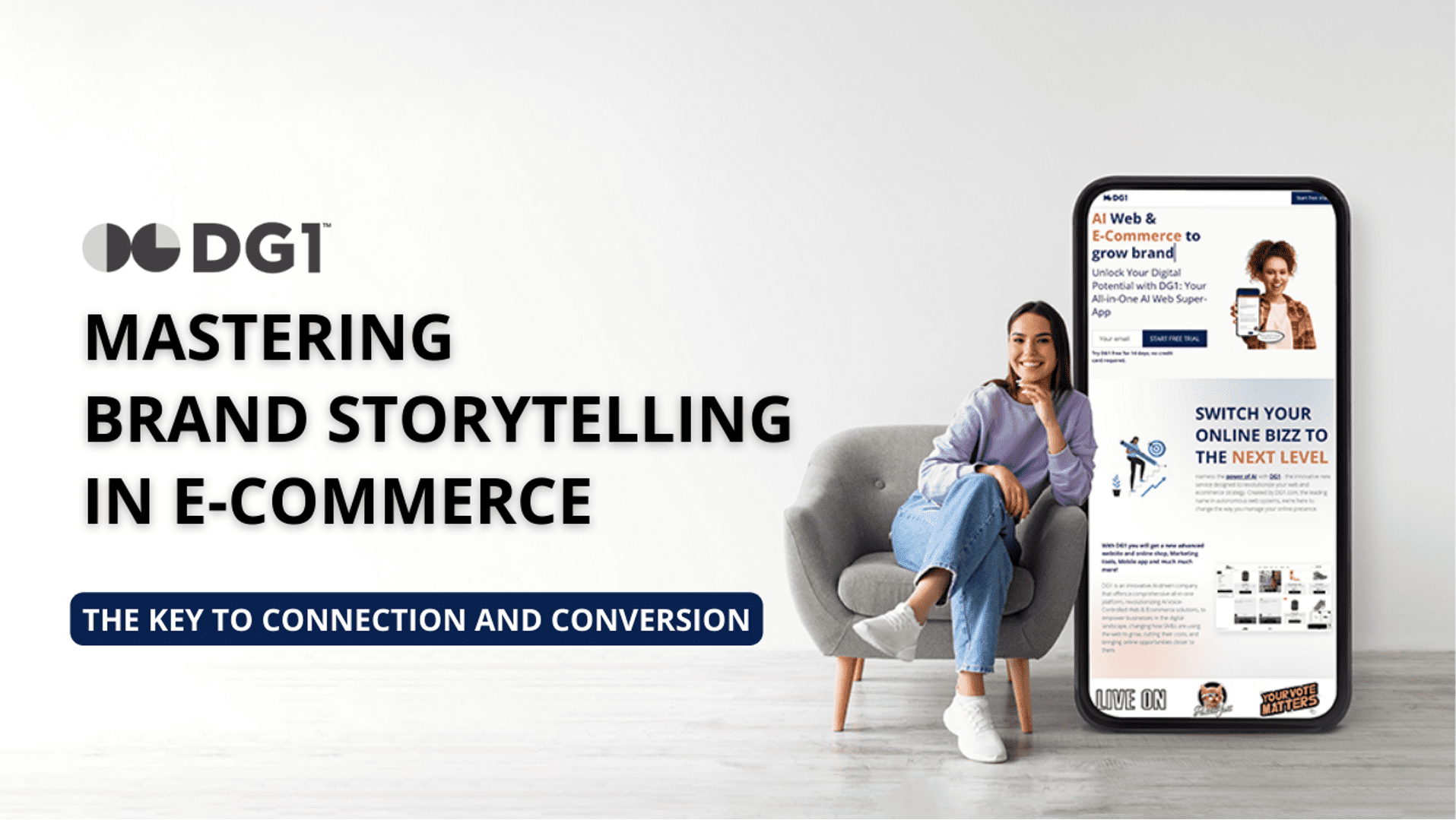Did you know that storytelling can increase the value of a product or service by over 20 times? Let's explore how brand storytelling in e-commerce creates such a profound impact.
In the digital age, e-commerce is not just about selling products; it's about telling a story. Brand storytelling in e-commerce goes beyond traditional marketing, creating a narrative that connects customers with your brand on a deeper level. This introduction will explore how compelling storytelling can transform customer interactions into memorable experiences, turning visitors into loyal brand advocates.
Three Elements of a Powerful Brand Story
A compelling brand story is composed of several critical elements that, when combined, create a narrative that profoundly resonates with your audience and strengthens your brand identity. Let's break down these components:
1. Authenticity
This is the cornerstone of any powerful brand story. Authenticity means being true to your brand's values, history, and mission. It involves sharing real stories, genuine emotions, and honest experiences that your business has gone through. For example, a brand that promotes environmental sustainability should genuinely engage in and advocate for green practices. Authenticity builds trust and credibility with your audience, as consumers are more likely to engage with a brand they perceive as genuine and transparent.
2. Relatability
A brand story should relate to your target audience. It needs to connect with them on a personal level, addressing their needs, challenges, and aspirations. By understanding your audience's demographics, preferences, and lifestyles, you can craft a story they see themselves in. For instance, if your target audience is young entrepreneurs, your brand story might focus on innovation, overcoming obstacles, and the spirit of entrepreneurship. Relatability makes your brand approachable and engaging, encouraging a deeper emotional connection with your audience.
3. Clear Narrative Arc
Every compelling story has a clear structure – a beginning, middle, and end. This narrative arc takes the audience on a journey. It includes elements like the setting, the protagonist (your brand or customer), the conflict or challenge, and the resolution. The beginning sets the stage and introduces the brand; the middle discusses the challenges or the journey, including how the brand or product solves a problem; and the end highlights the success or transformation. A well-structured narrative arc keeps the story focused and engaging, making it easier for the audience to follow and understand your message.
Crafting Your Brand Story: A Step-by-Step Guide (3 Steps)
Creating a brand story isn't about fictional tales; it's everywhere, compellingly presenting your brand's truth. This guide will walk you through the steps to uncover and articulate your brand's essence, from identifying core values to translating them into a narrative that speaks to your audience.
Step 1. Integrating Your Story Across Your E-Commerce Platform
To create a seamless brand experience, it's crucial to integrate your brand story across every aspect of your e-commerce platform. Here are practical tips for achieving this:
Website Design and User Interface:
Homepage: Use your homepage to introduce your brand story. This can be through a welcome message, a banner, or a short video encapsulating your brand's journey and values.
About Us Page: Dedicate a page to delve deeper into your story, including the origins, mission, and people behind the brand.
Consistent Aesthetics: Ensure your website's color scheme, typography, and imagery reflect your brand's personality and story. For instance, an eco-friendly brand might use earth tones and nature-inspired design elements.
Product Descriptions and Imagery:
Descriptions: Infuse your product descriptions with elements of your brand story. For example, if craftsmanship is a part of your story, highlight the artisanal process in product descriptions.
Images and Videos: Use visuals that align with your narrative. If your brand emphasizes adventure, use imagery that evokes a sense of exploration.
Customer Service:
Tone of Voice: Train your customer service team to communicate in a way that reflects your brand's values and story. For example, a brand with a friendly, casual story should use a similar tone in customer interactions.
Storytelling in Resolutions: Relate to your brand's mission and values when solving customer problems. This reinforces your commitment to your story and builds deeper customer relationships.
Marketing Campaigns:
Campaign Themes: Design marketing campaigns that tell parts of your brand story. For instance, a campaign focusing on sustainability for a brand that values environmental consciousness.
Email Marketing: Use email newsletters to share updates and stories about your brand, such as behind-the-scenes looks, customer stories, or milestones that align with your brand narrative.
Content Marketing:
Blog Posts: Regularly publish blog posts that explore topics related to your brand story. For example, a tech company might write about innovations in their field.
Social Media: Share snippets of your brand story on social media. This could be throwback posts, customer stories, or celebrations of company milestones.
Packaging and Brand Collaterals:
Packaging Design: Your product packaging is an opportunity to tell your brand story. Include elements like branded tags, messages, or eco-friendly packaging if it aligns with your story.
Collaterals: Ensure that all your brand collaterals (business cards, brochures, etc.) are consistent with your story in terms of design and content.
Step 2. Measuring the Impact: Brand Storytelling and ROI
To gauge the effectiveness of your brand storytelling and its return on investment (ROI), measuring various metrics that reflect customer engagement, brand perception, and sales performance is essential. Here's how you can do it:
Engagement Metrics:
Website Traffic: Monitor the traffic on pages where your brand story is featured, like the 'About Us' page. An increase in visits can indicate growing interest in your brand.
Social Media Engagement: Track likes, shares, comments, and views on posts related to your brand story. High engagement rates suggest that your story is resonating with your audience.
Time Spent on Site: Use analytics tools to measure how long visitors spend on your storytelling pages. Longer durations can imply that visitors are engaging with your content.
Brand Perception Metrics:
Surveys and Feedback: Conduct customer surveys to understand how your brand story affects their perception of your brand. Questions can focus on brand trust, value alignment, and overall sentiment.
Social Listening: Use social listening tools to track mentions of your brand and analyze the sentiment of these mentions. Are people talking positively about your brand and its story?
Sales Data:
Conversion Rates: Analyze the conversion rates before and after implementing your brand storytelling. An increase can be attributed to more effective branding.
Repeat Customer Rate: Measure the rate of repeat purchases. Customers who connect with your brand story are more likely to be loyal and make repeated purchases.
Average Order Value: Check if there's an increase in the average order value, which can indicate that customers, influenced by your brand story, are willing to spend more.
Content Performance Metrics:
Content Shares and Saves: Track how often your content, especially storytelling content, is shared and saved. This indicates the value and impact of your content.
Email Open and Click-Through Rates: For storytelling through email marketing, monitor open and click-through rates. High rates suggest that your story is compelling enough to prompt action.
Customer Advocacy Metrics:
Net Promoter Score (NPS): Measure your NPS to gauge customer loyalty and the likelihood of them advocating for your brand based on your story.
Referral Rates: Track referrals to see if satisfied customers are bringing in new customers, potentially as a result of your compelling brand story.
Step 3. Evolving Your Story: Keeping It Fresh and Relevant
To ensure your brand story stays dynamic and relevant, it's important to periodically revisit and update it to reflect your business's growth and the changing market landscape. Here's how you can keep your brand narrative fresh and aligned:
Regular Review and Update:
Schedule regular intervals (e.g., annually or bi-annually) to review your brand story. Assess if it still aligns with your current business model, values, and market position.
Update your story to include new achievements, milestones, or changes in your business direction.
Stay Tuned to Market Trends:
Keep an eye on industry trends and consumer behaviors. Adapt your story to stay relevant in the context of these evolving trends. For example, if sustainability becomes a major consumer focus, and your brand has taken significant steps in this area, incorporate this into your narrative.
Incorporate Customer Feedback and Insights:
Gather feedback from your customers about your brand and its story. Use this information to make your story more customer-centric.
Utilize customer success stories or testimonials to add new dimensions to your brand story.
Monitor Competitor Moves:
Keep an eye on how competitors are evolving their branding. While you should stay true to your unique story, understanding the competitive landscape can provide valuable insights.
Leverage New Media and Technology:
Utilize new media formats and technological advances to tell your story in innovative ways. For instance, use augmented reality (AR) or virtual reality (VR) to offer immersive storytelling experiences.
Involve Your Team and Stakeholders:
Engage with your employees, stakeholders, and loyal customers in the storytelling process. They can provide fresh perspectives and ideas for evolving the narrative.
Use internal stories, such as employee experiences or community initiatives, to add depth to your brand story.
Reflect on Your Brand's Evolution:
Your story should mirror the growth and changes in your business. If your business expands its product line or enters new markets, your story should reflect these developments.
Experiment with Different Storytelling Approaches:
Don't be afraid to experiment with different styles or angles in your storytelling. This can keep your content fresh and engaging.
The Future of Branding in E-Commerce
In summary, the essence of brand storytelling transcends mere products and services, forging emotional bonds, building trust, and setting your brand apart in the competitive e-commerce landscape. A compelling brand story enhances customer loyalty and engagement and becomes a pivotal factor in distinguishing your brand. As the digital marketplace continues to evolve, the art of brand storytelling will increasingly become a cornerstone of successful e-commerce branding, vital for creating meaningful connections and driving business growth.
At DG1, we understand the transformative impact of a well-crafted brand story and are committed to helping you realize this potential. Whether you're looking to refine your narrative or integrate it seamlessly across your digital presence, our team of experts is ready to assist. We invite you to explore the possibilities with DG1 and take the first step towards a compelling brand story. Schedule a call with our team to discuss your needs or for those eager to experience our platform firsthand, sign up for a free trial at dg1.com/free-trial. Embrace the power of storytelling with DG1 and watch your e-commerce business soar to new heights.


